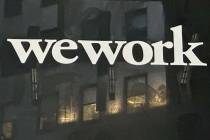Don’t believe the hike
It's the dead of winter, so what's up with the summer-like surge in gasoline prices?
Local fuel costs have jumped to their highest levels in more than a year, despite stable national demand for gasoline.
Despite the run-up, few analysts foresee a return to the record fuel and oil prices of 2008, and a key federal energy-forecasting agency predicted that average gasoline prices would stay under $3 a gallon nationwide in 2010.
That mid-range forecast might be of little comfort to consumers facing higher fuel budgets today. Since Dec. 14, fuel prices have gained 12 cents per gallon on average in Nevada, going from $2.73 to $2.85 on Thursday, according to travel club AAA. The last time you paid $2.85 for a gallon of unleaded gasoline was in October 2008. Back then, that price felt like a bargain, given that fuel prices had hit a record $4.28 a gallon in Las Vegas just four months earlier. Through late 2008 and into early 2009, gasoline prices continued to fall; a gallon of fuel averaged $2.35 nationwide in 2009, according to numbers from the U.S. Energy Information Administration.
Knowing what's behind the recent increase requires figuring out what's happening with crude oil, because petroleum makes up more than half a gallon of gasoline. Oil prices rose from just below $70 a barrel in mid-December to more than $83 a barrel in early January, and that's why you're paying more for fuel these days.
Credit a weak dollar and investor exuberance for January's higher oil prices. Crude is traded globally in U.S. dollars, so a softer dollar means buyers need more cash to purchase a barrel of petroleum. As for investors, they're snapping up oil futures on a bet that an improving economy will goose energy consumption by the end of the year and into 2011.
The jump in fuel prices has real implications for economic vitality: Every 10-cent move upward in gasoline prices costs consumers almost $14 billion more in annual fuel expenses, wrote Peter Boockvar, an analyst with New York trading firm Miller Tabak & Co., last week.
Higher fuel prices also affect local tourists.
Visitors chartering limousines and buses already pay a $3-per-hour fuel surcharge set by the Nevada Taxicab Authority. Alan Waxler, president and chief executive officer of local charter-transportation company Alan Waxler Group, said he fears the authority could bump that surcharge to $4 if fuel prices keep rising. The company has begun replacing its fleet with hybrids and vehicles that run on biodiesel fuel to cushion the blow of higher gasoline prices.
"We try to be as thrifty and efficient as we can with the fuel we utilize. That's really the only thing we can do," Waxler said.
Businesses and consumers might not see much price relief in the first half of 2010. Gasoline prices traditionally surge in the spring, as oil refineries shut down to switch from winter fuel blends to summer recipes, and travelers hit the road for warm-weather vacations. Denton Cinquegrana, West Coast markets editor with the Oil Price Information Service in New Jersey, said he wouldn't be surprised to see the national average, currently at $2.75, hover near $3 per gallon in the spring. Nevada's average typically runs 10 cents to 12 cents above national levels.
AAA doesn't project price trends, but Michael Geeser, a spokesman for AAA Nevada, said history shows that motorists should count on an uptick in fuel prices from spring to mid-summer.
"I don't think anybody's predicting records will be broken this year, but given that we're starting a dollar ahead of where we were last year, prices could get steep toward summer," Geeser said.
The Energy Information Administration predicts that oil prices will average $80 a barrel in 2010, with an average of $2.84 for a gallon of gasoline.
Few observers expect oil prices to jump substantially from their current levels by the end of 2010. Analysts say crude remains overpriced when weighed against going rates for other commodities, and today's supply-demand balance just doesn't warrant much-higher oil prices.
Cinquegrana said he believes oil should be trading in the mid-$60s, where it was last year. That cost would translate into gasoline prices ranging from 35 cents to 60 cents below today's rates, he said.
"Demand, for lack of a better term, is in the toilet," Cinquegrana said. "I don't think the economy has gotten that much better. There are still a lot of people out of work, and demand has been in the tank for much of the last year." The fleet of cars on the road today is also more fuel-efficient than it was a few years ago, and that curbs demand for fuel. Plus, oil refiners are operating their plants at just 80 percent of production capacity, so there's plenty of room to expand output if demand rises, Cinquegrana added.
Phil Flynn, an energy analyst with PFGBest, wrote in a Wednesday report that over the long range, oil prices should drop to around $44 a barrel.
But John Felmy, chief economist with the American Petroleum Institute, said he believes oil is priced right for now, mostly because worldwide inventories of crude remain steady. For oil to be overvalued, you'd need to see big stockpiles of crude build up globally, and that just hasn't happened, he said. Also, the International Energy Agency predicts that, as economies around the world continue to recover from the recession, global demand for crude will rise in coming years to a level greater than consumption before the downturn, so it's not unreasonable to anticipate higher crude prices.
Still, petroleum costs have eased off their winter run-up in the last few days. They closed Thursday at $79.39, down 26 cents from Wednesday and noticeably below the $83.18 they reached on Jan. 6.
Flynn's explanation for the price decline starts with China, the growth machine that's supposed to absorb every spare drop of global crude to power its hungry economy. The Chinese government said earlier last week that the country's banks must boost their cash-reserve requirements, which could mean less money for economic expansion there. With China "ready to let some air out of its expanding bubble," oil supplies might not be as tight as analysts expected, so investors have tweaked their oil bets downward, Flynn said.
What's more, a larger meltdown in the prices of commodities ranging from precious metals to corn also affected oil prices, Flynn said. And U.S. supplies of refined petroleum products such as heating oil and diesel fuel rose 3.6 million barrels from Jan. 1 to Jan. 8, while gasoline inventory jumped 6.8 million barrels in the same week. Crude-oil stores increase 1.2 million barrels. The result? "A total bearish smackdown," Flynn said.
In addition to the strength of the dollar and the health of the economy, expect geopolitical issues to affect gasoline prices in 2010. Possible sanctions against Iran for its efforts to go nuclear and civil unrest in Nigeria could pinch oil supplies. The hurricane season, which runs from May to November, could disrupt refining and importing activity along the U.S. Gulf Coast; early estimates from Colorado State University's hurricane-forecast team call for an above-average year for storm activity.
Even the upcoming Winter Olympics could affect fuel prices.
Geeser said consumers tend to stay in and cluster around the television during the games, and that cocooning could mean a drop in demand that brings lower oil and fuel prices in a month or so.
Contact reporter Jennifer Robison at jrobison @reviewjournal.com or 702-380-4512.
AVERAGE FUEL COST
Nevada starts 2010 with the seventh-highest gasoline prices.
State price per gallon
1. Hawaii $3.390
2. Alaska $3.376
3. California $3.062
4. New York $2.948
5. Connecticut $2.911
6. Washington $2.894
7. Nevada $2.850
8. Illinois $2.847
9. District of Columbia $2.835
10. Pennsylvania $2.827
SOURCE: AAA























